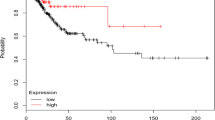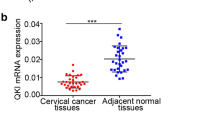Abstract
Cervical cancer is the fourth most common cause of mortality in women worldwide. In this study we investigated the effect of a tumour suppressor microRNA miR-214 in modulating the cell death against chemotherapeutic drugs like Doxorubicin, Cisplatin and Paclitaxel. CRISPR-facilitated knockdown and plasmid-based overexpression of miR-214 was performed in cervical cancer cell lines HeLa, C33A and CaSki. It was observed that knocking out miR-214 resulted in reduced apoptosis and cell migration upon drug treatments; while overexpression of miR-214 resulted in marginal increase in apoptosis and cell migration when treated with drugs. However, miR-214 had very little effect on production of reactive oxygen species. Our results also indicate that Doxorubicin was least effective and Paclitaxel most effective in inducing cell death. A combination of miR-214 overexpression and Paclitaxel treatment was found to be most effective in inducing cell death in cervical cancer cells. Analysis of cell cycle phases followed by apoptotic markers also showed that miR-214 overexpression along with Paclitaxel treatment caused an increase in PARP and decline of PI-3 kinase/Akt levels. Therefore, miR-214 levels determine the fate of the cancer cell during chemotherapeutic treatment.









Similar content being viewed by others
References
Adams JM and Cory S 2018 The BCL-2 arbiters of apoptosis and their growing role as cancer targets. Cell Death Differen. 25 27–36
Bhaskaran M and Mohan M 2014 MicroRNAs: history, biogenesis and their evolving role in animal development and disease. Vet. Pathol. 51 759–74
Bray F, Ferlay J, Soerjomataram I, Siegel RL, Torre LA and Jemal A 2018 Global cancer statistics GLOBOCAN estimates of incidence and mortality worldwide for 36 cancers in 185 countries. Cancer J. Clin. 68 394–424
Caberg J-HD, Hubert PM, Begon DY, Herfs MF, Roncarati PJ, Boniver JJ and Delvenne PO 2008 Silencing of E7 oncogene restores functional E-cadherin expression in human papillomavirus 16-transformed keratinocytes. Carcinogenesis 29 1441–7
Chandrasekaran KS, Sathyanarayanan A and Karunagaran D 2017 MicroRNA-214 suppresses growth, migration and invasion through a novel target, high mobility group AT-hook 1, in human cervical and colorectal cancer cells. Brit. J. Cancer 116 e8–e8
Chaudary N, Pintilie M, Jelveh S, Lindsay P, Hill RP and Milosevic M 2017 Plerixafor improves primary tumor response and reduces metastases in cervical cancer treated with radio-chemotherapy. Clin. Cancer Res. 23 1242–1249
Chen Y, Ke G, Han D, Liang S, Yang G and Wu X 2014 MicroRNA-181a enhances the chemoresistance of human cervical squamous cell carcinoma to cisplatin by targeting PRKCD. Exp. Cell Res. 320 12–20
Dang Y-P, Yuan X-Y, Tian R, Li D-G and Liu W 2015 Curcumin improves the paclitaxel-induced apoptosis of HPV-positive human cervical cancer cells via the NF-κB-p53-caspase-3 pathway. Exp. Therapeut. Med. 9 1470–1476
Dasari S and Bernard Tchounwou P 2014 Cisplatin in cancer therapy: Molecular mechanisms of action. Eur. J. Pharmacol. 740 364–378
Drozd E, et al. 2016 Up-regulation of glutathione-related genes, enzyme activities and transport proteins in human cervical cancer cells treated with doxorubicin. Biomed. Pharmacother. 83 397–406
Frediani JN and Fabbri M 2016 Essential role of miRNAs in orchestrating the biology of the tumor microenvironment. Mol. Cancer 15 42
Ganguly N and Parihar SP 2009 Human papilloma virus E6 and E7 oncoproteins as risk factors for tumorigenesis. J. Biosci. 34 113-123
Granados López A and López J 2014 Multistep Model of cervical cancer: participation of miRNAs and coding genes. Int. J. Mol. Sci. 15 15700–15733
He J and Jiang B-H 2016 Interplay between reactive oxygen species and MicroRNAs in cancer. Curr. Pharmacol. Rep. 2 82–90
He H, Zhang H, Li Z, Wang R, Li N and Zhu L 2015 miRNA-214: Expression, therapeutic and diagnostic potential in cancer. Tumori J. 101 375–83
Hientz K, Mohr A, Bhakta-Guha D and Efferth T 2017 The role of p53 in cancer drug resistance and targeted chemotherapy. Oncotarget 8 8921–8946
Kawai S, et al. 2018 Identification of miRNAs in cervical mucus as a novel diagnostic marker for cervical neoplasia. Sci. Rep. 8 7070
Kurata JS and Lin R-J 2018 MicroRNA-focused CRISPR-Cas9 library screen reveals fitness-associated miRNAs. RNA rna.066282.118
Lam C, Yeung A, Tsang TY, Yau PL and Kwok TT 2017 Human papillomavirus type 16 E6 suppresses microRNA- 23b expression in human cervical cancer cells through DNA methylation of the host gene C9orf3. Oncotarget 8 12158–12173
Leisching G, Loos B, Botha M and Engelbrecht A-M 2015 Bcl-2 confers survival in cisplatin treated cervical cancer cells: circumventing cisplatin dose-dependent toxicity and resistance. J. Transl. Med. 13 328
Li J, Wang Y, Wang K, Wang Z, Jia D, Yang B and Xiong C 2017 Downregulation of miR-214-3p may contribute to pathogenesis of ulcerative colitis via targeting STAT6. BioMed Res. Int. 2017 1–7
Lin S and Gregory RI 2015 MicroRNA biogenesis pathways in cancer. Nat. Rev. Cancer 15 321–333
Liu Y, Zhou H, Ma L, Hou Y, Pan J, Sun C, Yang Y and Zhang J 2016 MiR-214 suppressed ovarian cancer and negatively regulated semaphorin 4D. Tumor Biol. 37 8239–48
Lo A and Qi L 2017 Genetic and epigenetic control of gene expression by CRISPR-Cas systems. F1000Research 6 https://doi.org/10.12688/f1000research.11113.1
Lorusso D, Petrelli F, Coinu A, Raspagliesi F and Barni S 2014 A systematic review comparing cisplatin and carboplatin plus paclitaxel-based chemotherapy for recurrent or metastatic cervical cancer. Gynecol. Oncol. 133 117–123
Magal SS, Jackman A, Ish-Shalom S, Botzer LE, Gonen P, Schlegel R and Sherman L 2005 Downregulation of Bax mRNA expression and protein stability by the E6 protein of human papillomavirus 16. J. Gen. Virol. 86 611–621
Network TCGAR 2017 Integrated genomic and molecular characterization of cervical cancer. Nature 543 378–384
Peng X, et al. 2014 Autophagy promotes paclitaxel resistance of cervical cancer cells: involvement of Warburg effect activated hypoxia-induced factor 1-α-mediated signaling. Cell Death Dis. 5 doi: 10.1038/cddis.2014.297
Penna E, Orso F and Taverna D 2015 miR-214 as a key hub that controls cancer networks: small player, multiple functions. J. Inves. Dermatol. 135 960–969
Prasad S, Gupta SC and Tyagi AK 2017 Reactive oxygen species (ROS) and cancer: Role of antioxidative nutraceuticals. Cancer Lett. 387 95–105
Real NE, Castro GN, Darío Cuello-Carrión F, Perinetti C, Röhrich H, Cayado-Gutiérrez N, Guerrero-Gimenez ME and Ciocca DR 2017 Molecular markers of DNA damage and repair in cervical cancer patients treated with cisplatin neoadjuvant chemotherapy: an exploratory study. Cell Stress Chaperones 22 811–822
Robichaud N and Sonenberg N 2017 Translational control and the cancer cell response to stress. Curr. Opin. Cell Biol. 45 102–109
Roy S, Kar M, Roy S, Saha A, Padhi S and Banerjee B 2018 Role of β-catenin in cisplatin resistance, relapse and prognosis of head and neck squamous cell carcinoma. Cell. Oncol. 41 185–200
Sander JD and Joung JK 2014 CRISPR-Cas systems for editing, regulating and targeting genomes. Nat. Biotechnol. 32 347–355
Sen P, Ganguly P and Ganguly N 2017 Modulation of DNA methylation by human papillomavirus E6 and E7 oncoproteins in cervical cancer (Review). Oncol. Lett. 15 11–22
Sen P, Ghosal S, Hazra R, Arega S, Mohanty R, Kulkarni KK, Budhwar R and Ganguly N 2019 Transcriptomic analyses of gene expression by CRISPR knockout of miR-214 in cervical cancer cells Genomics 112 1490–1499
Servín-González L, Granados-López A and López J 2015 Families of microRNAs expressed in clusters regulate cell signaling in cervical cancer. Int. J. Mol. Sci. 16 12773–12790
Sharma A 2017 Chemoresistance in cancer cells: exosomes as potential regulators of therapeutic tumor heterogeneity. Nanomedicine 12 2137–2148
Sharma T, Hamilton R and Mandal CC 2015 miR-214: a potential biomarker and therapeutic for different cancers. Future Oncol. 11 349–363
Shen Y, Zhou J, Li Y, Ye F, Wan X, Lu W, Xie X and Cheng X 2014 miR-375 mediated acquired chemo-resistance in cervical cancer by facilitating EMT. PLoS ONE 9 e109299
Tomasetti M, Amati M, Santarelli L and Neuzil J 2016 MicroRNA in metabolic re-programming and their role in tumorigenesis. Int. J. Mol. Sci. 17 754
Wang J-Y and Chen L-J 2019 The role of miRNAs in the invasion and metastasis of cervical cancer. Biosci. Rep. 39 doi: 10.1042/BSR20181377
Wang J-M, Ju B-H, Pan C-J, Gu Y, Li M-Q, Sun L, Xu Y-Y and Yin L-R 2017b MiR-214 inhibits cell migration, invasion and promotes the drug sensitivity in human cervical cancer by targeting FOXM1. Am. J. Translat. Res. 9 3541–3557
Wang F, Liu M, Li X and Tang H 2013 MiR-214 reduces cell survival and enhances cisplatin-induced cytotoxicity via down-regulation of Bcl2l2 in cervical cancer cells. FEBS Lett. 587 488–495
Wang T, Liu Z, Shi F and Wang J 2016 Pin1 modulates chemo-resistance by up-regulating FoxM1 and the involvements of Wnt/β-catenin signaling pathway in cervical cancer. Mol. Cell. Biochem. 413 179–187
Wang F, Tan W-H, Liu W, Jin Y-X, Dong D-D and Zhao QL X-J 2018 miR-214 in cancer proliferation. Eur. Rev. Med. Pharmacol. Sci. 22 1891–1898
Yang Y, Liu Y and Li G and Li PGL and HS 2018 microRNA‑214 suppresses the growth of cervical cancer cells by targeting EZH2. Oncol. Lett. 16 5679–5686
Yilmaz A, Alp E, Ilke Onen H and Menevse S 2016 Reduced BCL2 and CCND1 mRNA expression in human cervical cancer HeLa cells treated with a combination of everolimus and paclitaxel. Contemp. Oncol. 20 28–32
Zhao H, Diao C, Wang X, Xie Y, Liu Y, Gao X, Han J and Li S 2018 LncRNA BDNF-AS inhibits proliferation, migration, invasion and EMT in oesophageal cancer cells by targeting miR-214. J. Cell. Mol. Med. 22 3729–3739
Acknowledgements
This study was funded by DST-SERB, India.
Author information
Authors and Affiliations
Corresponding author
Additional information
Communicated by Ullas Kolthur-Seetharam.
Corresponding editor: Ullas Kolthur-Seetharam
Electronic supplementary material
Below is the link to the electronic supplementary material.
Rights and permissions
About this article
Cite this article
Sen, P., Ghosal, S., Hazra, R. et al. CRISPR-mediated knockdown of miR-214 modulates cell fate in response to anti-cancer drugs in HPV-negative and HPV-positive cervical cancer cells. J Biosci 45, 80 (2020). https://doi.org/10.1007/s12038-020-00054-1
Received:
Accepted:
Published:
DOI: https://doi.org/10.1007/s12038-020-00054-1




